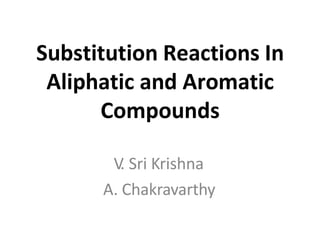
substitutionreactions-130121103848-phpapp01 (1).pptx
- 1. Substitution Reactions In Aliphatic and Aromatic Compounds V . Sri Krishna A. Chakravarthy
- 2. Substitution Reactions-Definition • Reactions which involve the replacement or substitution of one or more atoms or groups of a compound by other atoms or groups are known as SUBSTITUTION REACTIONS.
- 3. Classification • Based on the nature of substituents involved: A:Q + B· A:Q + B- 1. Free Radical Substitution A:B + Q· 2. Electrophilic Substitution A:B + Q- 3. Nucleophilic Substitution A:B + Q+ A:Q + B+
- 4. Free Radical Substitution • Radical substitution reactions are initiated by radicals in the gas phase or in non-polar solvents. • For example, methane and chlorine react in presence of sunlight or heat to give methylchloride
- 5. Mechanism of free radical substitution • Light energy or heat causes homolytic fission of chlorine producing chlorine radicals which attack methane to form methylchloride.
- 6. Termination by formation of stable molecules: • When the ratio of methane to chlorine is high, methylchloride is formed predominantly. • When chlorine is in excess, all hydrogens are replaced to give carbon tetrachloride.
- 7. Electrophilic Substitution • When the substitution involves attack by an electrophile, it is electrophilic substitution. • This occurs in both aliphatic and aromatic compounds and hence classified as: • Electrophilic Aliphatic Substitution • Electrophilic Aromatic Substitution
- 8. Electrophilic Aliphatic Substitution • This reaction is similar to Nucleophilic Substitution reaction and are differentiated based on their mechanisms as SE1 and SE2 • Examples: Nitrosation Ketone halogenation Keto-enol tautomerism Aliphatic diazonium coupling Carbene insertion into C-H bonds
- 9. Electrophilic Aromatic Substitution • A = Electrophile • B = Lewis Base
- 10. Examples • Nitration: • Sulphonation: • Halogenation:
- 11. Examples • Friedel-Craft’s alkylation: • Friedel-Craft’s acylation:
- 12. Effect of Substituents • Any substituents, if present, affect both the regioselectivity and speed of the reaction. • In terms of regioselectivity, the substituents may be ortho-para directing or meta directing. • In terms of kinetics, substituents may increase (activating) or decrease (deactivating) the rate of reaction.
- 13. Activating Substituents: • They stabilize the cationic intermediate formed during the substitution by donating electrons into the ring system, by either inductive effect or resonance effects. Examples are toluene, aniline and phenol Deactivating Substituents: • These destabilize the intermediate cation and thus decrease the reaction rate by withdrawing electron density from the aromatic ring. Examples are nitrobenzene, benzaldehyde and trifluoromethylbenzene
- 17. • Non-halogen groups with atoms that are more electronegative than carbon, such as a carboxylic acid group (CO2H) draw substantial electron density from the pi system. • These groups are strongly deactivating groups. • Additionally, since the substituted carbon is already electron-poor, the resonance contributor with a positive charge on this carbon (produced by ortho/para attack) is less stable than the others. • Therefore, these electron-withdrawing groups are meta directing Meta directors
- 18. Nucleophilic Substitution • Nucleophilic substitution involves the displacement of a nucleophile by another. • Nucleophilic substitution may be any one of the following: – Nucleophilic aliphatic substitution – Nucleophilic aromatic substitution
- 19. Aliphatic Nucleophilic substitution • In 1935, Edward D. Hughes and Sir Christopher Ingold studied nucleophilic substitution reactions of alkyl halides and related compounds. • They proposed two main mechanisms— the SN1 reaction and the SN2 reaction. • S stands for chemical substitution, N stands for nucleophilic, and the number represents the kinetic order of the reaction.
- 20. SN1 Reaction Mechanism • L = Leaving group • Nu- = Attacking Nucleophile
- 21. SN2 Reaction Mechanism • L = Leaving group • Nu- = Attacking Nucleophile
- 22. Factor SN1 SN2 Kinetics Rate = k[RX] Rate = k[RX][Nuc] Primary alkyl Never Good Secondary alkyl Moderate Moderate Tertiary alkyl Excellent Never Leaving group Less Basic Less Basic Nucleophilicity Unimportant Important Preferred Solvent Polar protic Polar aprotic Stereochemistry Racemisation(more inversion possible) Walden Inversion Rearrangements Common Rare Eliminations Common, especially with basic nucleophiles Only with heat and basic nucleophiles
- 23. Examples • Organic reductions with hydrides, for example R-X → R-H using LiAlH4 (SN2) • Hydrolysis reactions such as R-Br + OH− → R-OH + Br− (SN2) or (SN1) R-Br + H2O → R-OH + HBr • Williamson ether synthesis R-Br + OR'− → R-OR' + Br− (SN2) • The Wenker synthesis, a ring-closing reaction of aminoalcohols. • The Finkelstein reaction, a halide exchange reaction • The Kolbe nitrile synthesis, the reaction of alkyl halides with cyanides.
- 24. Aromatic Nucleophilic substitution • A nucleophilic aromatic substitution is a substitution reaction in which the nucleophile displaces a good leaving group,on an aromatic ring. There are 6 nucleophilic substitution mechanisms encountered with aromatic systems.
- 26. The aromatic SN1 mechanism encountered with diazonium salts
- 29. ANRORC mechanism ANRORC stands for Addition of the Nucleophile, Ring Opening, and Ring Closure in nucleophilic attack on ring systems
- 31. Examples • In the Bamberger rearrangement N- phenylhydroxylamines rearrange to 4- aminophenols. The nucleophile is water. • In the Sandmeyer reaction and the Gattermann reaction diazonium salts react with halides. • The Smiles rearrangement is the intramolecular version of this reaction type.
- 32. References • Reactions, Rearrangements and Reagents by S.N.Sanyal • Reactions and Reagents by O.P.Agarwal • www.wikipedia.org • Google Images
- 33. Thank You